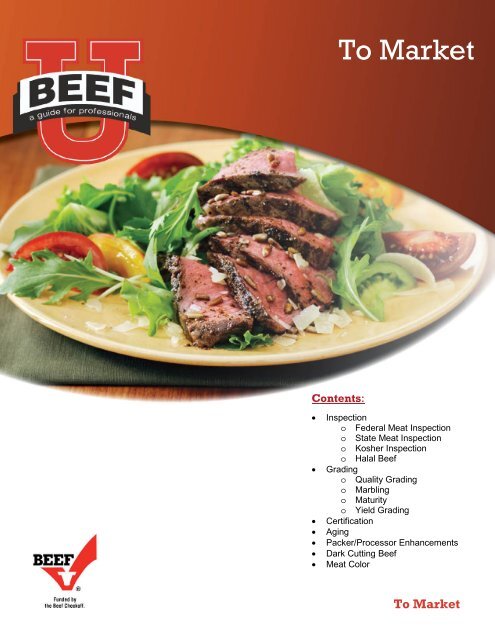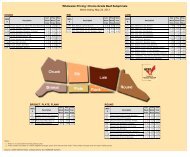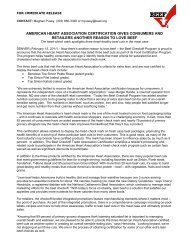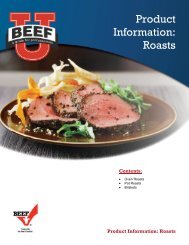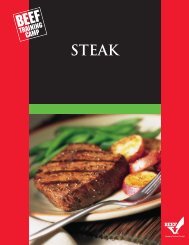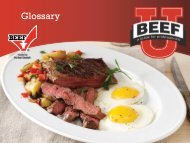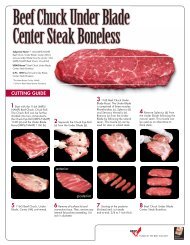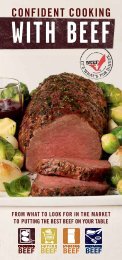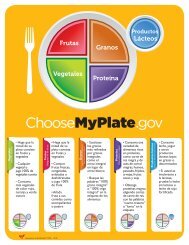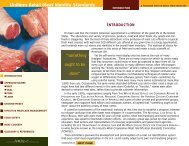Fact Sheet - Beef Foodservice
Fact Sheet - Beef Foodservice
Fact Sheet - Beef Foodservice
Create successful ePaper yourself
Turn your PDF publications into a flip-book with our unique Google optimized e-Paper software.
To Market<br />
Contents:<br />
• Inspection<br />
o Federal Meat Inspection<br />
o State Meat Inspection<br />
o Kosher Inspection<br />
o Halal <strong>Beef</strong><br />
• Grading<br />
o Quality Grading<br />
o Marbling<br />
o Maturity<br />
o Yield Grading<br />
• Certification<br />
• Aging<br />
• Packer/Processor Enhancements<br />
• Dark Cutting <strong>Beef</strong><br />
• Meat Color<br />
To Market
Inspection<br />
The meat industry, with more than a century of regulatory history, is considered by many<br />
to be the most highly regulated segment of the food industry. The U.S. meat inspection<br />
program began in 1891 when Congress passed a general meat inspection act, providing<br />
for the inspection of cattle. Subsequently, the Federal Meat Inspection Act of 1906 made<br />
inspection mandatory for all meat that crossed state lines. More recently, the<br />
Wholesome Meat Act of 1967 required that inspection of meat sold within a state under<br />
an approved state inspection program meet inspection requirements at least as stringent<br />
as those of the federal system.<br />
Federal meat inspection is the responsibility of the Food Safety and Inspection Service<br />
(FSIS), the public health agency in the U.S. Department of Agriculture (USDA). State<br />
meat inspection is the responsibility of each state’s government with partial funding<br />
support provided by the federal government. FSIS develops rules and regulations for the<br />
production of safe foods, ensuring that meat and poultry products are safe, wholesome<br />
and correctly labeled.<br />
The beef industry, however, also takes responsibility for producing the safest products<br />
possible. The responsibility for food safety begins with the livestock producer, continues<br />
through wholesaler/retailer operations (including meat inspection) and ends with the<br />
foodservice operator or the consumer who is ultimately responsible for the food’s<br />
preparation.<br />
Providing the safest beef in the world is the number one priority of America’s beef<br />
producers. From pasture to plate, each partner in the beef production chain has made<br />
significant strides in lowering the rate of foodborne illnesses and remains committed to<br />
the fight against foodborne pathogens such as E. coli O157:H7. Producers have<br />
invested more than $22 million in beef safety research since 1993, leading to the<br />
establishment of best practices which serve as a road map in reducing foodborne<br />
pathogens. The steady decline in incidence rates of these pathogens is evidence that<br />
the beef supply is safer than ever.<br />
To assist producers in food safety programs on ranches and farms, the National<br />
Cattlemen’s <strong>Beef</strong> Association (NCBA) has initiated the <strong>Beef</strong> Checkoff-funded “<strong>Beef</strong><br />
Quality Assurance Program” to educate farmers and ranchers on the proper way to<br />
administer animal health products and to address other food safety issues. Farmers and<br />
ranchers take their food safety responsibilities seriously when raising livestock, including<br />
administering approved animal health products.<br />
Similarly, foodservice operators and retailers must use safe food preparation and<br />
handling practices at all times, to assure not only continued confidence from their<br />
customers, but also to avoid potential fines or other legal actions. Several industry trade<br />
organizations, including NCBA on behalf of the <strong>Beef</strong> Checkoff Program, provide<br />
educational and training programs to assist foodservice and retail establishments in<br />
meeting their food safety responsibilities.
Federal Meat Inspection<br />
The Meat Inspection Program assures that only meat from healthy animals enters the<br />
food chain, and assures that facilities and equipment meet sanitation standards.<br />
However, the Meat Inspection Program also includes:<br />
• Inspection of meat at various stages of processing<br />
• Temperature monitoring for both fresh and cooked meat<br />
• Review of packaging and labels used for fresh and processed meat<br />
• Control and monitoring of the use of approved food additives<br />
• Control and monitoring of imported meat<br />
Since meat inspection is mandatory for all beef sold at the foodservice and retail levels,<br />
U.S. taxpayers pay for these inspection programs. Therefore the cost of inspection is not<br />
included in the cost of the meat purchased.<br />
Cattle and their carcasses are examined for wholesomeness before, during and after the<br />
harvesting process by an in-plant FSIS inspector.<br />
Inspectors view organs, lymph nodes and other tissues for abnormalities. If<br />
wholesomeness is questionable at any time, the inspector will retain a beef carcass or<br />
beef products for further testing. If a carcass or any edible part from an animal is found<br />
to be unwholesome, it is condemned and placed in a separate area until it can be<br />
disposed of properly, thereby preventing its entrance into the food chain.<br />
Several other tests are routinely performed by inspectors to assure the safety of the<br />
meat supply. For example, by using statistical procedures FSIS is able to check for more<br />
than 100 unauthorized compounds and monitors approximately 50,000 carcasses per<br />
year. If misuse is found, the carcass is traced back to its source. In addition to possible<br />
legal action against the source, animals subsequently marketed from the establishment<br />
where the misuse or error occurred are closely monitored until the problem is completely<br />
corrected.<br />
When beef or beef products have passed the meat inspection process, a round<br />
inspection legend containing an abbreviation “U.S. Inspected and Passed” and the<br />
official establishment number assigned to that specific processing plant is stamped on<br />
each primal cut (with edible ink). If a beef cut or product is packaged in a box, the<br />
inspection stamp is placed on the outside of that container. The stamp must also be<br />
placed on every prepackaged processed meat product that has been federally<br />
inspected.<br />
State Meat Inspection<br />
<strong>Foodservice</strong> operators and retailers typically purchase beef and beef products that have<br />
been processed under the Federal Meat Inspection program, because most distributors<br />
sell products in several states, if not nationally. However, 28 U.S. states do maintain<br />
federally-approved state inspection programs. A processing plant that sells meat<br />
products exclusively within its state may operate under a state regulated inspection<br />
program, which must meet the same criteria as USDA (federal) inspection. State meat
inspection stamps also use edible ink and a symbol that is often the outline of the shape<br />
of that state, with the official establishment number within the stamp.<br />
Kosher Inspection<br />
The term “kosher” is derived from the Hebrew word meaning “fit and proper” or “properly<br />
prepared.” Kosher meat is processed under the supervision of persons authorized by the<br />
Jewish faith to meet the requirements of the Mosaic and Talmudic laws.<br />
While the kosher inspection procedures are independent of the requirements for federal<br />
or state meat inspection, kosher meats must also be inspected concurrently by federal or<br />
state meat inspectors and must also meet the federal/state inspection requirements prior<br />
to sale.<br />
A primary requirement for kosher meat is that it comes from an animal that has split<br />
hooves and chews its cud. Since hogs do not meet this requirement, ham, bacon and<br />
other pork products cannot be kosher.<br />
A specially trained rabbi must perform the harvest of the animal. Following carcass<br />
cutting, the fresh meat is soaked and salted on all parts, and the meat is then allowed to<br />
drain. Salting is critical to the koshering process, since it draws out the remaining blood<br />
from the meat as required by biblical law (Leviticus 17:14, “You shall not eat the blood of<br />
any creature, for the life of every creature is blood; whoever eats it shall be cut off.”)<br />
Cuts of meat from the hindquarter are not available as kosher meat because the sciatic<br />
nerve and its adjoining muscles may not be eaten.<br />
Once the beef carcass has met both kosher and federal/state inspection requirements,<br />
the kosher inspection stamp is applied to the appropriate parts of the carcass. The<br />
kosher designation may then be applied to cuts and packages of kosher products.<br />
Halal <strong>Beef</strong><br />
Halal is the Arabic word meaning “lawful” or “permitted” and is the dietary standard for<br />
practicing Muslims under Islamic law. The USDA has had a policy on Halal labeling in<br />
effect since 1996. The general requirements for Halal state that an animal must be<br />
humanely treated en route to and at the processing plant. The throat must be slit in a<br />
specific way, while the word “Allah” (God) is said. The blood must then be drained from<br />
the body.<br />
Essentially, all foods are considered Halal except for the following:<br />
• Swine/pork and its by-products<br />
• Animals improperly harvested<br />
• Animals killed in the name of anyone other than Allah (God)<br />
• Alcohol and intoxicants<br />
• Carnivorous animals, birds of prey and land animals without external ears<br />
• Blood and blood by-products<br />
• Foods contaminated by any of the above
The requirements for Halal meat are that an animal or poultry has to be harvested in a<br />
ritual way known as Zibah. Zibah requires that animals be alive and healthy at the time<br />
of harvest, that a Muslim perform the ritual and that the carcass be drained of all blood.<br />
In addition, there are other rules and edicts that have to be followed, including Halal<br />
processing must not be done anywhere where pigs are processed (as pork is forbidden),<br />
the animal must be fed and given water prior to harvest, one animal cannot see another<br />
animal being harvested and, whenever possible, the animal should face Mecca.<br />
Products prepared by federally inspected meat packing plants identified with labels<br />
bearing references to Halal or Zabiah Halal must be handled according to these and<br />
other Islamic law and under Islamic authority.<br />
Grading<br />
The acceptability and value of beef carcasses is determined primarily by: (1) the quality<br />
of the beef, and (2) the yield of saleable beef. U.S. Department of Agriculture (USDA)<br />
grades for beef carcasses provide a system of sorting a rather heterogeneous (varied)<br />
supply of beef into smaller, more homogeneous (uniform) groups (i.e., Quality Grade<br />
Choice-Yield Grade 2) for marketing. These grades promote uniform market reporting,<br />
provide a tool for expressing and comparing value and prices, and enhance foodservice<br />
and consumer marketing.<br />
Established in 1927, the USDA meat grading program, administered by the Agricultural<br />
Marketing Service (AMS) of the USDA, sets “standards” (which are written descriptions)<br />
of quality and cutability (yield of edible meat) that are used in buying and selling meat.<br />
These standards allow livestock owners to gear production for specific grades based on<br />
market demand. Packers can segregate carcasses and cuts into groups of similar<br />
grades and retailers can buy the grades of meat appropriate for their markets. For<br />
consumers, grading provides assurance that the product conforms to an established set<br />
of standards that predict palatability. Today, in larger plants computer imaging<br />
technology assists USDA graders.<br />
There are federal grade standards for beef, veal, pork and lamb. However there are<br />
more grade designations for beef carcasses due to the wider variation in age and weight<br />
of cattle compared to other meat animals. The meat grading standards designate eight<br />
“quality” grades for beef (Prime, Choice, Select, Standard, Commercial, Utility, Cutter<br />
and Canner) and five “yield” grades (depicted numerically from 1 to 5).<br />
Only beef carcasses (not individual cuts) are graded. However, this grade designation is<br />
carried forward to all wholesale/primal and retail cuts derived from a graded carcass.<br />
Unlike meat inspection, which is mandatory, participation in the meat grading program is<br />
voluntary, and the cost of this service is paid for by the meat packers. This cost may be<br />
included in the cost of meat purchased by consumers or foodservice operators.<br />
Today, approximately 95% of all federally inspected slaughter gets a grade. Fed cattle<br />
are young cattle marketed out of feedlots after an average of 100-150 days on a grain<br />
based diet.
Of the carcasses graded in the U.S., the quality grade distribution is approximately 3%<br />
Prime, 57% Choice and 40% Select. The yield grade distribution is approximately 11%<br />
Yield Grade 1, 40% Yield Grade 2, 40% Yield Grade 3, and 9% Yield Grades 4 and 5.<br />
Less than 1% of older cattle that could qualify for Commercial or Utility are graded.<br />
Since beef grading is a voluntary program, packers are not required to quality grade<br />
and/or yield grade every carcass. Therefore, the packer has the option to quality grade<br />
only, to yield grade only, to grade for both quality and yield grades, or to not grade a<br />
carcass at all.<br />
The packer may instruct the USDA grader to officially quality and/or yield grade only<br />
those carcasses meeting specific marketing needs. Often a packer will specify, for<br />
instance, that only USDA Quality Grade Prime, Choice and Select and Yield Grade 1, 2,<br />
and 3 be identified with a grade stamp. A carcass that is officially graded is “rolled” with<br />
a blue ink stamp or “shield” (using edible ink) to designate the grade. The stamp is rolled<br />
along the back from the round to the chuck and over the clod and brisket regions.<br />
“No roll” is a term given to those carcasses that do not officially receive a grade stamp<br />
“roll” at the packing facility. Therefore, they are not rolled with either an official quality or<br />
yield grade stamp. There is no official USDA grade standard for “no roll,” nor is there an<br />
official “no roll” stamp.<br />
With the increased use of the Select grade in both retail and foodservice operations, and<br />
since carcasses can have a combination of grading options (yield, quality or both), fewer<br />
carcasses are remaining as “no roll” beef. However, any carcass of any quality or yield<br />
grade may be a “no roll” carcass, if the packer decides not to have a grading roll applied<br />
to it. Therefore, purchases from a “no roll” sales category are less likely to be as uniform<br />
in quality or yield as those carrying an official USDA grade designation.<br />
Carcasses from the lower beef quality grades (Commercial, Utility, Cutter and Canner)<br />
are normally not graded, since they are seldom sold directly to the public. The meat from<br />
these carcasses is both wholesome and nutritious, but because these cuts are less<br />
tender, they are commonly used in ground beef, sausages and other manufactured meat<br />
products. However, some of the more tender cuts (ribs and loins) of the lower grades<br />
may be tenderized and used in restaurants that feature lower-priced beef entrees.<br />
As will be seen in the following sections, carcass fat plays an important role in<br />
determining both quality and yield grades of beef carcasses. There are several types of<br />
fat associated with a beef carcass:<br />
• Marbling, or intramuscular fat, is the fat deposited within the muscle<br />
• Subcutaneous, or external fat, covers the outside of the carcass<br />
• Seam fat, or intermuscular fat, is the fat lying between the muscles<br />
• Internal fat (KPH - kidney, pelvic, heart) protects the internal organs
Marbling is an important factor in determining the quality grade of a beef carcass,<br />
typically having a positive effect on the palatability of the cooked meat. However,<br />
subcutaneous, seam and internal fats, all factors in determining the yield grade of a<br />
carcass, each have a negative impact on the final yield grade.<br />
Quality Grading<br />
This part of the grading system provides the purchaser with an estimate of the<br />
palatability, or taste appeal (tenderness, juiciness and flavor), of the cooked meat from a<br />
carcass. The quality grade is determined by evaluating the following characteristics of a<br />
beef carcass:<br />
Marbling<br />
“Marbling” (intramuscular fat) is the small flecks of visible fat on the cut surface of<br />
fresh meat. In determining the grade of a beef carcass, the marbling is evaluated<br />
on a cut surface of the Ribeye muscle between the 12th and 13th ribs.<br />
The amount and distribution of marbling is a major criterion for grading beef. The<br />
marbling fat melts during cooking, thereby increasing the juiciness of the meat,<br />
contributing to its flavor and increasing its perceived tenderness.<br />
The “Official United States Standard for Grades of Carcass <strong>Beef</strong>” recognizes ten<br />
degrees of marbling. The six common degrees of marbling are -Moderately<br />
Abundant, Slightly Abundant, Moderate, Modest, Small and Slight.<br />
Maturity<br />
The younger the animal the more likely the meat will be tender, because as the<br />
animal matures, the connective tissue increases in amount, becomes tougher,<br />
and will not break down as easily when cooked. Younger cattle can qualify for<br />
Prime, Choice, Select or Standard. Meat from older cattle (over 42 months of<br />
age) can qualify only for Commercial, Utility, Cutter or Canner grades.<br />
During the grading process, the USDA grader does not have information as to<br />
the exact age of the animal from which the carcass originated. Consequently, the<br />
grader determines the physiological maturity of the animal on the basis of<br />
skeletal characteristics and the color and texture of the Ribeye muscle. The<br />
bones of young animals are soft, porous and red. As the animal gets older,<br />
bones and cartilage ossify, that is, they grow harder and turn white.<br />
The color and texture of the Ribeye muscle is also considered when determining<br />
the final maturity group for carcasses. Young cattle have muscle that is bright<br />
cherry-red and finely textured. The color of beef becomes progressively darker<br />
and the texture coarser as the animal matures.<br />
In determining the physiological maturity of the animal from which the carcass<br />
originates, the grader places each carcass into one of five maturity groups: A, B,<br />
C, D and E. A and B maturity groups represent carcasses from younger cattle<br />
(under 42 months of age), while C, D, and E maturity groups represent carcasses<br />
from older cattle (over 42 months of age).
Having determined the maturity group (i.e., A, B, C, etc.) and the degree of<br />
marbling (i.e., Modest, Small, Slight, etc.), the grader uses this chart to determine<br />
the relationship between the two factors, thereby arriving at the final Quality<br />
Grade.<br />
For instance, a carcass from a younger animal in the “A” maturity group with a<br />
“Modest” degree of marbling would be designated as a “USDA Choice” carcass.<br />
However, a “C” maturity carcass with the same degree of marbling (“Modest”)<br />
would be a “USDA Commercial” carcass.<br />
Yield Grading<br />
Yield grading is accomplished at the same time as quality grading and is performed by<br />
the same grading personnel. However, yield grading is not directly related to quality<br />
grading, and serves a different purpose for the industry.<br />
Yield grades identify differences in carcass cutability. Cutability is defined as the amount<br />
of saleable meat obtained from the carcass as boneless, closely trimmed retail cuts from<br />
the round, loin, rib and chuck.<br />
Yield Grades are especially useful at the purchasing level since they can help the<br />
purchaser identify which carcasses or cuts will provide the greatest yield of edible meat<br />
per pound. The lower the yield grade number (i.e., Yield Grade 1), the smaller the cutting<br />
losses, the less seam fat will be found within individual cuts, and the higher the cooking<br />
yield. Yield grades are of lesser direct value to the retail consumer since retail cuts are<br />
usually trimmed of excess fat prior to presentation for sale.<br />
However, yield grades can affect all purchasers of fresh beef, because cutting losses are<br />
an important factor in determining product price, and in turn, can directly impact<br />
foodservice and retail pricing strategies.<br />
There are five USDA Yield Grades, identified numerically as “USDA Yield Grade 1” to<br />
“USDA Yield Grade 5”. A Yield Grade 1 carcass has the greatest amount of saleable<br />
meat while a Yield Grade 5 carcass has the least.<br />
Since it is not practical to cut and fabricate every carcass into muscle, fat and bone to<br />
determine the boneless retail yield, a quick, repeatable and reliable procedure must be<br />
used to estimate carcass cutability. To do this, the USDA grader uses four carcass<br />
characteristics:<br />
1. External fat thickness measured in tenths of an inch at a specific point over the<br />
Ribeye muscle at the 12th rib (the same location as marbling is determined for<br />
quality grading)<br />
2. The amount of internal fat (kidney, pelvic and heart fat) expressed as a<br />
percentage of the carcass weight (%KPH fat)<br />
3. The area of the Ribeye muscle (in square inches) again measured at the 12th rib<br />
4. The carcass weight (an actual measure of carcass weight in pounds taken on the<br />
harvesting floor)
Fat thickness over the Ribeye and percent of kidney, pelvic and heart fat are indicators<br />
of total carcass fatness. As these measurements increase, the yield grade number<br />
increases (moves closer to Yield Grade 5), and the carcass becomes less desirable.<br />
The Ribeye area is an indicator of carcass muscularity. As the Ribeye area increases,<br />
the numerical yield grade decreases (moves closer to Yield Grade 1) and the carcass<br />
becomes more desirable.<br />
Although USDA has developed a formula for calculating the yield grade, as a practical<br />
matter the grader relies upon his or her experience and training to make this<br />
determination. However, the grader may check using the formula occasionally when<br />
requested to do so. The same process holds true for the USDA grader when determining<br />
the USDA Quality Grade.<br />
USDA Yield Grades are “rolled” onto the beef carcass at the same time as the USDA<br />
Quality Grade. However, the Yield Grade number placed on the carcass is “rounded<br />
down” in all cases by dropping any decimal. Therefore, a calculated Yield Grade of “3.1”<br />
for one carcass and one of “3.8” for another would result in both carcasses being rolled<br />
as “USDA Yield Grade 3” for marketing purposes.<br />
Certification<br />
Although “branding” is an increasingly popular concept in merchandising beef today, it is<br />
certainly not a new concept. Decades ago, recognized brands were commonplace, and<br />
names such as “Swift Premium” and “Armour Star” reflected a certain level of quality that<br />
was both understood and trusted by most consumers.<br />
In today’s increasingly competitive marketplace, however, it is difficult for beef marketers<br />
with less recognizable names to introduce branded products that will instill immediate<br />
customer confidence. However, by structuring such programs to include elements of<br />
federal programs that are both recognized and trusted by customers, the opportunity for<br />
success is enhanced.<br />
The Agricultural Marketing Service (AMS) of the U.S. Department of Agriculture (USDA)<br />
provides voluntary certification services to assist in the marketing of branded beef<br />
programs. This service provides for certification of specific carcass characteristics that<br />
are contained within each program’s published requirements. This AMS certification<br />
provides confidence throughout the marketing chain that the claims made were<br />
substantiated by independent third party oversight. AMS currently has approved<br />
certification services for over 40 beef programs, with each beef certification program<br />
varying in the level of claims for “quality.”<br />
The descriptions of these certified beef programs are available for review to determine if<br />
one or more meets specific needs with the confidence that the USDA has certified the<br />
claims made in each program.
Aging<br />
“Aging” refers to beef that is held under controlled refrigerated conditions for a period of<br />
time in order to maximize the tenderness of the product, and is used most commonly in<br />
loin and rib cuts. Aging occurs “postmortem” (after harvesting) as a natural enzymatic<br />
process in all muscles, and takes place whether beef is vacuum packaged or is in the<br />
form of carcasses or whole cuts.<br />
Two types of postmortem aging are used commercially:<br />
“Dry aging” refers to longer storage of carcasses or beef wholesale cuts at refrigerated<br />
temperatures with no protective packaging. It is critical with dry aging to carefully control<br />
refrigeration conditions to minimize microbial growth and dehydration losses.<br />
Aging in a refrigerated room at 32 – 34°F and 80-85% relative humidity, with air velocity<br />
of 0.5 to 2.5 m/sec, is typical. Dry aging under these conditions is sometimes continued<br />
for 21 to 28 days, and may impart a distinct “aged” flavor considered desirable by some<br />
consumers.<br />
“Wet aging” refers to storage at refrigerated temperatures in a sealed vacuum packaged<br />
bag. While relative humidity and air movement are not factors when wet aging, strict<br />
temperature control is important, and should be maintained at 32 - 36°F. <strong>Foodservice</strong><br />
operators or retailers who desire to further age beef received in vacuumed bags in their<br />
refrigerators should keep in mind that if they open these bags they are, in effect, “dry<br />
aging” the cuts, and should therefore maintain the appropriate dry aging conditions.<br />
Both types of aging have the same effect on tenderness, since the natural enzymes in<br />
the muscle continue to break down the connective tissue and enhance meat tenderness<br />
in either case.<br />
Wet aging is the typical method of aging beef today. One of the major differences<br />
between dry and wet aging is the microbial growth that may occur on the product during<br />
dry aging. As might be imagined, prolonged storage in the presence of air (dry aging)<br />
creates an excellent environment for bacterial growth and dehydration. The product<br />
loses 5% to 20% of its weight because of dehydration and the required trimming if the<br />
dry aging procedure is used. Vacuum packaging of beef, on the other hand, minimizes<br />
the ability of spoilage bacteria to grow and virtually eliminates trimming losses. Aging<br />
beyond 28 days has little benefit in enhancing beef palatability, and, in the case of dry<br />
aged product, may be detrimental due to increased microbial and dehydration losses.<br />
Aging can also be affected by individual muscle and by USDA Quality Grade.<br />
Research in the past had always been conducted on beef subprimals and not individual<br />
muscles. National Cattlemen’s <strong>Beef</strong> Association on behalf of The <strong>Beef</strong> Checkoff<br />
commissioned researchers at Colorado State University (2006 S. L. Gruber, K. E. Belk,<br />
J. D. Tatum, J. A. Scanga, G. C. Smith) to conduct a study to characterize postmortem<br />
aging (wet aging) of fresh (never frozen) individual beef muscles of two different quality<br />
grades (upper 2/3 USDA Choice and USDA Select). Overall findings of this study
suggest that tenderness of cooked beef was affected by individual muscle, USDA<br />
Quality Grade and length of aging. In general, USDA Select took longer than USDA<br />
Choice (upper 2/3) to complete the majority of all aging response.<br />
Packer/Processor Enhancements<br />
Most consumers enjoy beef “just the way it is” – that is, as tender and juicy cooked<br />
steaks, roasts or ground beef. Traditional methods of fabricating carcasses into<br />
individual steaks and convenient sized roasts and separating more tender from less<br />
tender cuts have contributed to great eating experiences for decades.<br />
However, as consumers’ tastes have evolved and our society has been introduced to an<br />
ever-growing variety of ethnic cuisines, today’s discerning customer often searches out<br />
those establishments that provide a variety of dining options.<br />
Progressive packers and processors are enhancing beef products at the processing<br />
level. By using items such prepackaged, ready-to-cook entrees, foodservice operators<br />
and retailers can expand offerings without extensive modifications to facilities or staff.<br />
One popular enhancement is the use of “marinating” technologies. The food industry<br />
defines a marinade as “… a mixture in which food is soaked, massaged, tumbled and/or<br />
injected to improve taste, tenderness or juiciness, or to impart other sensory attributes,<br />
such as color or flavor.” All prepackaged products must disclose on the label the amount<br />
of marinade and the ingredients used.<br />
Marination technology incorporates four basic elements: 1) closely trimmed beef, 2) a<br />
marinade solution, 3) a marination process and 4) a packaging system. The key<br />
difference among various marination processes is the degree of penetration and<br />
dispersion of the marinade, the amount of marinade absorbed, and the extent of<br />
tenderizing. A processor may use a variety of equipment (injectors, vacuum tumblers,<br />
vacuum massagers, etc.) that promote uniform distribution of marinade in beef. An<br />
unevenly distributed marinade can result in discoloration, a rubbery texture, pockets of<br />
strong flavor and/or uneven cooking.<br />
The ingredients in commercial marinating solutions perform specific functions. Primary<br />
ingredients – water, salt and phosphates – affect texture and water-holding capacity.<br />
Secondary ingredients – seasonings, acids and sweeteners – impart unique flavors.<br />
Primary marinade ingredients increase the meat’s water-holding capacity. Meat proteins,<br />
which make up about 20% of beef’s composition, can hold approximately four times their<br />
weight in water. Salts and phosphates enhance meat’s ability to hold water. This results<br />
in less moisture loss during cooking, thereby increasing the juiciness and perceived<br />
tenderness and can help minimize the impact of overcooking.<br />
Secondary ingredients (e.g., seasonings, sodium lactate, potassium lactate, sodium<br />
citrate, etc.) impart specific flavors, visual appeal and can provide extended shelf life.<br />
Trendy ethnic cuisines, such as Asian, Caribbean and Nuevo Latino, often influence<br />
marinade flavors. Today’s standby marinades, such as lemon pepper and teriyaki, are<br />
being joined by chili peppers, cilantro and other herbs. Care needs to be taken when<br />
adding seasonings to beef to complement its flavor. Unlike chicken and pork, beef has a
distinct, stand-alone flavor that your customers crave. Successful marinating depends on<br />
a balanced formulation and an effective processing technique. The challenge is to avoid<br />
certain pitfalls that could ultimately impact foodservice operations and customers at<br />
home.<br />
For example, maximizing water-holding capacity can result in a product with a rubbery<br />
texture and/or high sodium content. A rubbery texture can be minimized by incorporating<br />
less of certain ingredients (such as phosphates and salt) and by reducing the time and<br />
action in mixing and tumbling. This, however, can lower the water-holding capacity,<br />
which may result in excess purge. Therefore, the amount of water may also need<br />
adjusting.<br />
Citrus flavors, while popular, can also be tricky due to their acidity. The water-holding<br />
capacity of beef proteins is best at a neutral pH. If the pH of a marinade is too low,<br />
proteins break down rapidly and beef texture may become soft and mushy.<br />
Achieving a consistent marinade is challenging due to the number of variables involved.<br />
Water purity, mixing procedures, temperature, treatment process, packaging and batch<br />
size affect marinade success. Even the age, moisture content and specific cut of beef<br />
can affect product consistency.<br />
The best approach in process development, therefore, includes thorough testing of each<br />
specific formulation and process to meet the desired effect of the marinade. Ingredients<br />
and processes that optimize the quality of some products may reduce the performance<br />
of others. In the final analysis, perfect marinade depends on the desired final product.<br />
Benefits of Commercially Marinated <strong>Beef</strong>:<br />
• Enhances juiciness and minimizes consequences of overcooking<br />
• Enhances flavor and tenderness<br />
• Improves consistency<br />
• Provides a vehicle for incorporation of flavors and seasonings<br />
• Can be used to incorporate ingredients that increase shelf life<br />
Dark-Cutting <strong>Beef</strong><br />
Dark-cutting beef is beef with an abnormally dark lean color that is generally the result of<br />
reduced glycogen (muscle “sugar”) content in the muscle at the time the animal is<br />
harvested. This causes a higher muscle pH (less acid) after the carcass is chilled. This<br />
condition most often occurs as a result of excessive animal stress prior to harvest,<br />
although other stressful conditions (such as severe weather changes) may also cause<br />
dark-cutters.<br />
The dark color caused by this condition can range from barely evident to very dark. A<br />
USDA grader may lower the quality grade up to one full grade because of the darkcutting<br />
condition. Although the incidence in steers and heifers is relatively low (about a<br />
2%), it is estimated that dark cutters cost the beef industry over $5 for every fed<br />
steer/heifer marketed.
While the color of raw muscle cuts may be aesthetically unacceptable to the eye of the<br />
consumer, the “dark-cutting” condition does not affect the eating quality of the cooked<br />
lean. Dark-cutting beef is considered acceptable for many foodservice applications,<br />
because the beef appears the same after cooking as “normal” colored beef, while it is<br />
not typically accepted at retail where shoppers would see the product uncooked.<br />
One caution in utilizing dark-cutting beef, however, is that it does not have a shelf-life as<br />
long as other beef when it is held fresh or thawed. Therefore, care should be taken to<br />
keep it chilled until ready for cooking, and storage time should be kept to a minimum.<br />
Meat Color<br />
The color of fresh meat is related to a specific protein in muscles called “myoglobin.”<br />
Myoglobin is a protein very similar to hemoglobin, the oxygen-carrying protein in blood.<br />
In fact, myoglobin serves as the protein in muscles that receives oxygen from the<br />
hemoglobin blood, and makes this oxygen available to the muscle tissues.<br />
Myoglobin and hemoglobin are very similar in that each is an iron-containing protein.<br />
However, hemoglobin has four times the iron content as myoglobin, which enhances its<br />
ability to transport oxygen in the blood throughout the body. The amount of myoglobin in<br />
the muscles of different animals is what gives various meats their distinctive fresh colors.<br />
<strong>Beef</strong> muscle that has not been exposed to air (oxygen) is a purplish red color. The<br />
foodservice operator or customer will recognize a color change with vacuum packaged<br />
beef cuts. In the vacuum bag the color appears to be purple-red. However, once it has<br />
been exposed to the air, the color brightens to a bright, cherry-red.<br />
In both cases, the myoglobin in the muscle picks up oxygen from the air (called<br />
“oxygenation”) resulting in the bright cherry-red color. This color change is often referred<br />
to as “bloom.” Other color changes can also occur to myoglobin in meat. For instance,<br />
when fresh meat is exposed to oxygen in the air for a longer period of time (perhaps<br />
several days) the surface may change to a “brownish” color. In this case, a chemical<br />
change (called “oxidation”) occurs to the myoglobin resulting in the brown surface color.<br />
Since these cuts may have been exposed for several days, they may also be susceptible<br />
to the onset of microbial spoilage.<br />
Another familiar color change that is associated with meat cookery is that Myoglobin,<br />
along with other proteins in meat, “denatures” when cooked. As the myoglobin gradually<br />
denatures with increasing temperatures, the red color progressively changes to a<br />
browner cooked meat color. The higher the internal temperature of the meat the less red<br />
the cooked meat becomes, reflecting the “degree of doneness” of the cooked meat.<br />
Iridescence in raw and cooked beef is a naturally occurring phenomenon that does not<br />
affect quality or palatability. It appears as a blue-green or orange-red color in some raw<br />
and cooked beef. It’s associated with the interference of light waves reflected off the<br />
meat’s surface. <strong>Fact</strong>ors such as the beef’s surface texture and color, and the type,<br />
wavelength and angle of the light affect the intensity of the iridescence. Smooth meat<br />
surfaces may exhibit iridescence more vividly than rough surfaces.
<strong>Beef</strong> Color Dynamics<br />
Sometimes cooked fresh meat remains red on the surface or retains a red interior<br />
despite it being fully cooked. A classic example is meatloaf that remains pink in the<br />
center even when fully cooked or the appearance of an outside red ring on smoked or<br />
grilled meats. While all of the explanations are not known, some scientifically proven<br />
causes for this phenomenon are: (1) traces of nitrates in water supplies (when fresh<br />
meat comes in contact with this water the nitrate reacts chemically with the fresh meat<br />
pigment and results in the formation of the same pigment as when the food processors<br />
intentionally adds nitrates to produce cured meats); (2) traces of nitrites and nitrates in<br />
vegetable foods (fresh meats cooked in the presence of celery, turnips and other<br />
vegetables could be expected to show some red color depending on the soil in which the<br />
vegetables were grown and even lack of freshness in the vegetables – as vegetables<br />
deteriorate, the nitrate content lessons and more nitrite is formed); and (3) the use of<br />
pepper solution (which may contain a trace of natural nitrate). It has also been<br />
suggested that the presence of carbon monoxide in heating gases, exhaust gases and<br />
furnaces has led to the red ring on cooked meats.<br />
Resources<br />
For more information on how beef gets to market, please visit:<br />
• <strong>Beef</strong> Product Enhancement Research<br />
http://www.beefresearch.org/productenhancementresearch.aspx<br />
• Industry Guide for <strong>Beef</strong> Aging<br />
www.beefresearch.org/executivesummaries.aspx<br />
• USDA Food Safety and Inspection Service<br />
http://www.fsis.usda.gov/<br />
• USDA Agricultural Marketing Service – Grading, Certification and Verification<br />
http://www.ams.usda.gov/AMSv1.0/ams.fetchTemplateData.do?template=Templ<br />
ateA&navID=GradingCertificationandVerification&leftNav=GradingCertificationan<br />
dVerification&page=GradingCertificationAndVerification&acct=AMSPW


